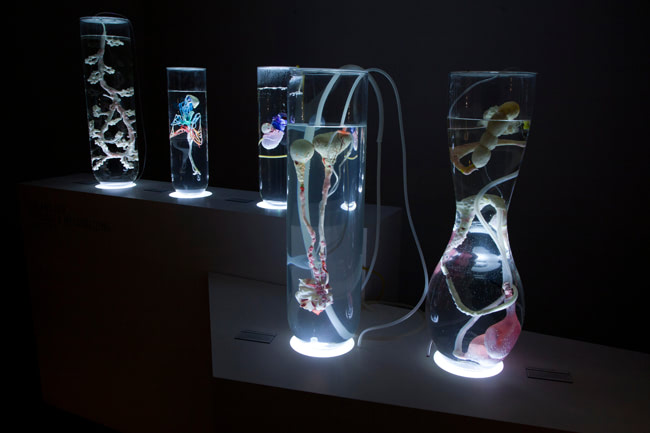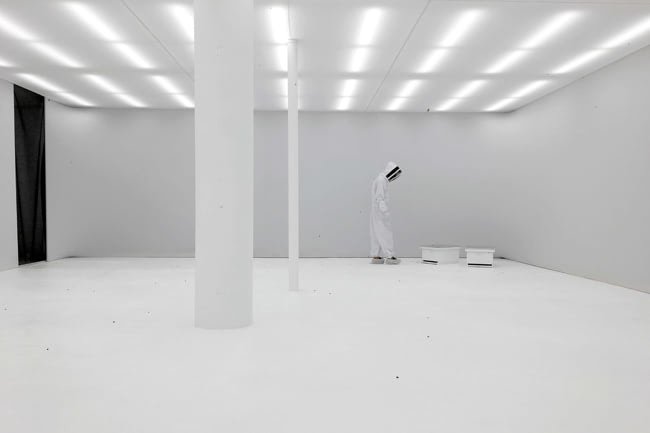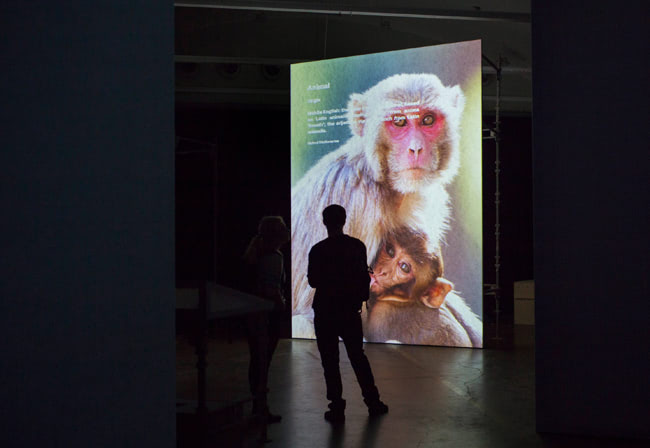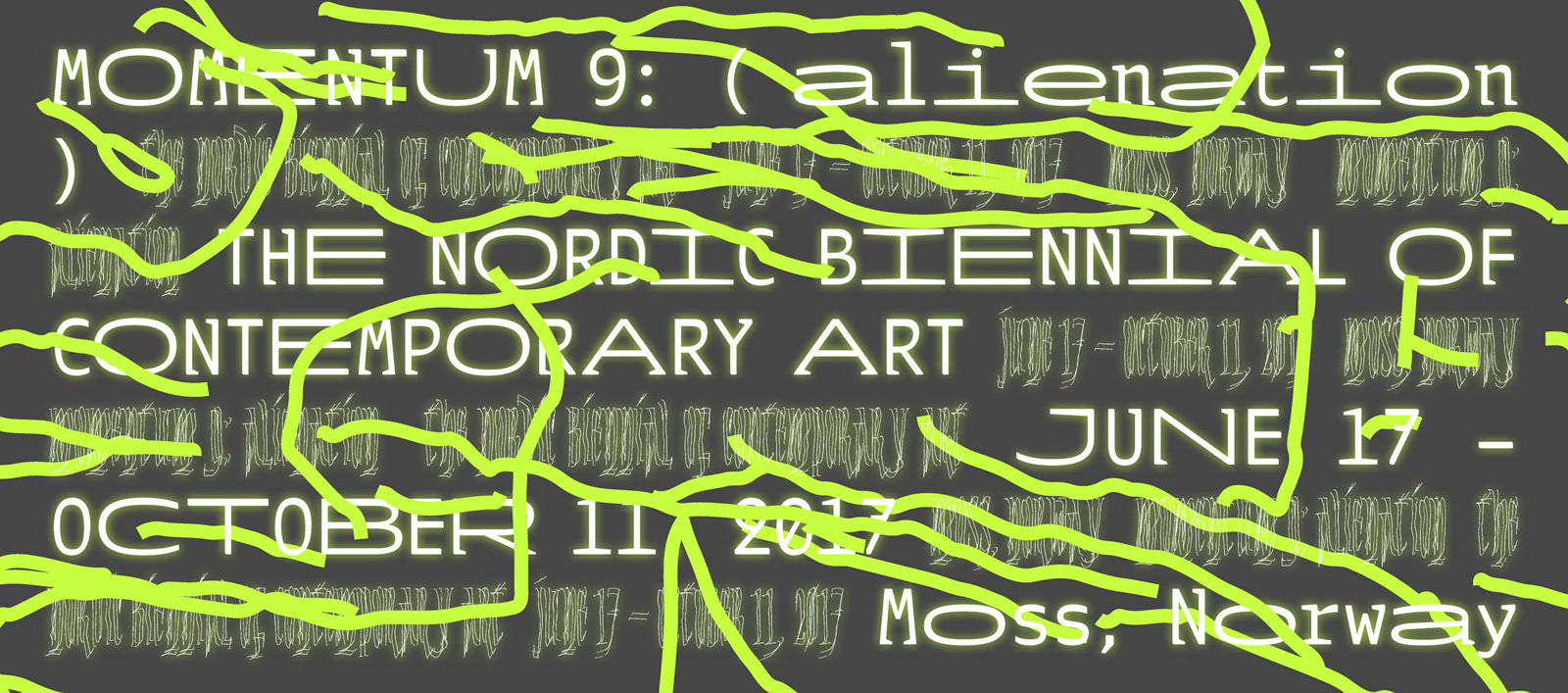This year Momentum, the Nordic biennial, celebrates its ninth edition in the lush landscape of Moss, Norway. Taking the thematic approach of Alienation, the team of curators (Ulrika Flink (SE), Ilari Laamanen (FI), Jacob Lillemose (DK), Gunhild Moe (NO) and Jón B.K Ransu (IS)) seeks to extrapolate new perspectives on the human condition subjected to the rapidly changing interconnected world through transdisciplinary explorations. Presenting a group of internationally renowned artists, the biennial addresses topical concerns of cultural and geographical borders, biopolitics and social inequality, to outline a series of strategies towards "extraordinary futures". We recently talked with one of the curators of the biennial, Ilari Laamanen, to peel the outcrops of the exhibition and explore its similarities with the next nature philosophy.
The idea of pure, untouched nature is long lost
We are intrigued by the curatorial concept of this year’s biennial, Alienation, can you tell us a bit about it?
The starting point of the concept was the realization that the world we live is widely disconnected, hard to comprehend, and oftentimes irrational. It seems to be more and more difficult to find a common ground in terms of ideology and philosophy, as the changes in nature, technology and society are rapid and concurrent. This time we live in cries for cross-pollination of methods and new knowledge.
People also seem to be more and more lost with the sense of community. Many things might be more shared than before, yet it seems that on a fundamental humane level we are isolated from one another, and alienated even from our immediate surroundings. Our curatorial team invited contributors with different backgrounds to tackle these issues through an interdisciplinary approach and speculation.
![]() Patricia Piccinini, Atlas, Silicone, fiberglass, human hair, car paint, 84x54x50cm, 2012.
Patricia Piccinini, Atlas, Silicone, fiberglass, human hair, car paint, 84x54x50cm, 2012.
It can be said that the theme of the biennial is related to the next nature topic. What is next nature for you?
The idea of pure, untouched nature is long lost. We are forced to look at the consequences of human actions on the planet. The idea of next nature relates intimately to our habitat. The domestication and endless utilization of different species is a valid concern, as are the effects of the countless substances that are migrating into our bodies, with and without us being aware of them, thus different kind of variations of nature and human-made systems are connected to this phenomenon. It is also fascinating to contemplate what kind of hybrids we are ourselves and what we might turn into in the future.
Are we becoming cyborgs?
I believe that some of the more interesting developments focus on physical body. Indeed, it is not far-fetched to say that our lives are becoming more and more cyborg-like. People use technology to build, enhance and keep track of their bodies. Technology provides means to help people support their malfunctioned systems and enables them to alter or change their gender.
Solastalgia is a sense of existential distress and alienation caused by climate change
A new sense of freedom comes with all these developments, but there’s perhaps some melancholy too, as many of our actions are detrimental to environment. In the biennial, artist Jussi Kivi presents Moon Woods, a nocturnal scenario made of mostly synthetic materials. Kivi’s diorama channels the concept of solastalgia, a sense of existential distress and alienation from one’s most immediate surroundings caused by climate change. This sense of being fundamentally out of place, or longing for something, seems typical of our time.
Can you elaborate on the ecological perspective in relation to the body?
One should also think of plastic waste in the ocean and how that is affecting different species inhabiting the waters. The litters the fish and crustaceans consume change them and when consumed by people our bodies get affected too. In a similar way, the water we put into our bodies is affected by countless of chemicals and it is becoming quite difficult to find waters that haven’t been polluted yet. In Momentum 9, Pinar Yoldas focuses on this issue and presents new kinds of crossbreeds our actions might produce in a not so distant future.
 Pinar Yoldas, Ecosystem of Excess, Detail of an installation, 2014.
Pinar Yoldas, Ecosystem of Excess, Detail of an installation, 2014.
One of our research topics ‘Wild Systems’ investigates how our systems have become so complex that they now behave like independent ecologies (think about an algorithm running our financial systems, or GM organisms thriving in the wild). How to cope with that?
Humans did not bring the nature into being and they cannot fully control it. So from this perspective one wants to start considering if there is enough respect towards nature. While a lot of progress is being constantly made in all disciplines, the big mystery remains: how do all the developments and breakthroughs connect to one another, or do they even?
So many of the existing systems around - and within - us are still too complex for us to understand. Think the potential of microbes, for instance, and how they affect our physical being and even consciousness. Sonja Bäumel’s Being Encounter is a work in the biennial that address this issue: although we claim to know so much about the things surrounding us, we are oftentimes clueless when it comes to mapping the processes in our bodies.
So many of the existing systems around us are still too complex for us to understand
Jenna Sutela’s work circles around complex biological and computational systems. For the Momentum 9 Biennial she created two site-specific installations. Let’s Play: Life depicts a computer playing through the Game of Life that simulates systems in the real world. It has been proposed as a model for the self-replication of robots. Her second installation Sporulating Paragraph introduces an alien organism operating like a microscopic machine or virus and taking the form of a living graffiti. The work, inspired by 2014 Jeff VanDerMeer’s novel Annihilation, seeks to interfere with our fundamental illusion of control.
Do you think technology alienates people from people?
I don’t think that technology alienates people from people per se, I would rather say that it is becoming more and more important to cultivate our inter-human relationships in favor of virtual ones. New technological equipment or gadget does not automatically mean progress, as the media theorists like Friedrich Kittler and Marshall McLuhan stated decades ago. On a similar note: not every message delivered through media is factual. Thus criticality towards media and the ability to be self-reflective becomes more crucial than ever before.
Criticality towards media and the ability to be self-reflective becomes more crucial than ever before
Is technology capable of enhancing our humanity?
Advancements in technology have enabled freer access to information and data than earlier, so at least in theory this should create greater understanding of us as humans and how we should act and interact on this planet. When we consider the Western culture and its strong embrace of dichotomies and categories, it would be easy to feel worried about technology taking over nature. But as we might want to take a more holistic approach and see all things on some level connected, it would make sense to accept the growing role of technology in our lives and rather make the connection to the fundamental human need to expand its intellect, creativity and ability to invent.
 Mediated Matter, Synthetic Arpiary, Honeybee Hive Installation in the Synthetic Apiary environment, excerpt from a video, 2016.
Mediated Matter, Synthetic Arpiary, Honeybee Hive Installation in the Synthetic Apiary environment, excerpt from a video, 2016.
What does science fiction mean to you?
Science fiction can be a useful tool for both speculating future, and touching upon current matters from a distanced perspective. Take Momentum 9 artist Kapwani Kiwanga, for instance, who in her Afrogalactica performance series intentionally confuses truth and fiction to unsettle hegemonic narratives and to create spaces in which marginal discourses can flourish.
How much of our fear is part of cultural conditioning and fiction?
When considering mainstream film productions in the science fiction genre, the setup is typically built around the threat against humanity and this planet we inhabit. A big question in relation to the theme of the biennial is: does the threat come from the external environment or from within? And how much of the fear people feel is constructed inside their heads and how much of it is part of cultural conditioning and fiction?
Instead of thinking about stereotypical creatures from outer space, our curatorial team leaned more towards abstract nowhere, where the question is not so much about the threat anymore, but about the realization that we are constantly exposed to, and invited to engage with, matters previously unfamiliar to us. In terms of science fiction related inspiration, Todd Haynes film Safe (1995) and Dennis Villeneuve’s Arrival (2016) are some examples of the more nuanced works that resonate with the biennial’s thematics.
 Museum of Nonhumanity, installation view at Suvilahti, Helsinki, 2016. Photo by Terike Haapoja.
Museum of Nonhumanity, installation view at Suvilahti, Helsinki, 2016. Photo by Terike Haapoja.
Tell us about the role that insects play in the biennial.
In the context of this biennial, the idea of an alien is not necessarily something that comes from outer space, but can be more likely found in our everyday surroundings. The relationship between humans and insects is too often simply utilitarian, or insects are considered a nuisance. We wanted to shed light on this complex relationship through three different works, which can be also seen as connected to the broader themes of the biennial.
Mediated Matter by Neri Oxman tackles the issue of possible bee extinction (caused by strong pesticides) through their ‘Synthetic Apiary’. The video documentation, featured in Momentum 9 highlights the pioneering project that enabled the birth of first ever bee in a synthetic, man-made environment. The work is typical for Mediated Matter who, as they put it, “focuses on the nature-inspired design and design-inspired nature”.
The idea of an alien is not necessarily something that comes from outer space, but can be found in our everyday surroundings
Búi Bjarmar Aðalsteinsson’s Fly Factory breeds insect larvae for human consumption. The project started from the designer’s desire to offer more sustainably produced protein and to alleviate potential food shortages in the future. The factory feeds insects on food waste and recycles nutrients they excrete as fertilizer.
Lastly, Museum of Nonhumanity, a project by artist Terike Haapoja and author Laura Gustafsson presents the history of the distinction between the humans and other animals, and how this imaginary boundary has been used to oppress human and nonhuman beings. In the section of the museum that deals with disgust, insects are used as an example of species of lesser value: and how certain types of insects have been also used as abusive names for people of lesser value. The project illuminates the worst sides of human actions towards nature and one another. It also makes the audience contemplate their own mechanisms of making distinction between themselves and the others.
No man is an island
The biennial takes place in Moss, Norway; how important is the geographical location - or Nordic context, as you put it - for the exhibit?
While years ago the biennial started out as a platform for Nordic art and talent, it became an international, thematic exhibition that addresses topical, important issues in culture and visual arts. For this edition’s curatorial team it was important to spend as much time as possible in the Norwegian city of Moss, where the biennial takes place, to build a connection between the featured works and the local surroundings.
I, for instance, found it highly interesting that Momentum Kunsthall, one of the main exhibition venue of the biennial, used to be a brewery. It was also fascinating to learn more about the ecosystem of the neighboring river and how it was in danger of being severely damaged due to plans of building new tower blocks in that area. Furthermore, I got the chance to familiarize with an amazing collection of old taxidermy animals and laboratory equipment from local schools. It was great to collaborate with many of the local people who do not come from the art or design background.
What makes the biennial stand out?
What makes this biennial stand out is its genuine concern about the topics it addresses - and the very special group of contributors it features. Nordic contemporary art scene, or cultural field in the general, is not strongly market-driven, which enables different kinds of practices and a sense of freedom in the decision-making. While connected to the local, the biennial also has international ambitions, and the featured works take part in discussions that deal with topical issues of our contemporary culture all over the world: no man is an island.
Ilari Laamanen is a curator based in New York City. Having a background in media studies and cultural studies in Nordic Universities, he focuses on thematic, interdisciplinary projects. Recent curatorial work includes: Momentum 9: Alienation (Moss, Norway, 2017), Fashion after Fashion (Museum of Arts and Design, NYC, 2017), and Ordered Dance (Station Independent Projects, NYC, 2017).
You can find Momentum9: Alienation until October 11th at various locations in Moss, Norway. Watch the trailer below.
Want to stay up to date about the latest next nature news, events and other NNN projects? Make sure to join Next Nature Network and never miss a thing!
[mc4wp_form id="72385"]

Share your thoughts and join the technology debate!
Be the first to comment